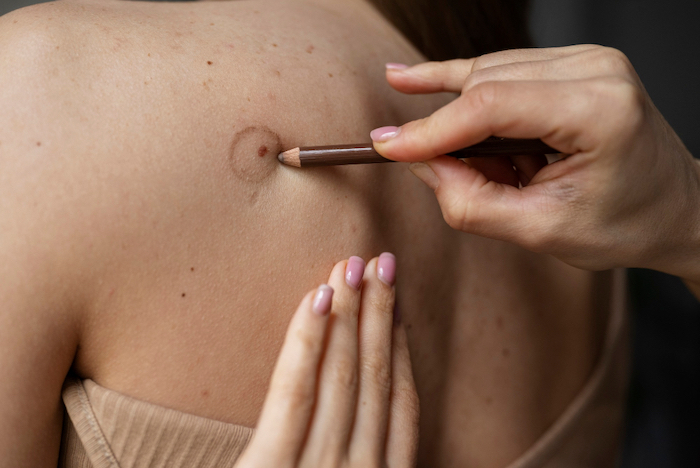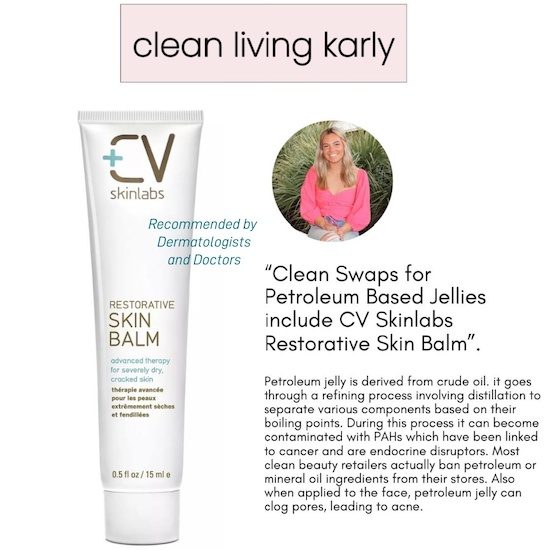How to Heal Smart After Skin Cancer Surgery

Skin cancer surgery is a critical step in removing cancerous cells and preventing the spread of the disease.
But what do you do for your skin after the surgery?
As we observe Skin Cancer Awareness Month this May, we wanted to share some tips on how to care for your skin after surgery.
Skin Cancer Surgery: Understanding This Disease
Skin cancer is the most common cancer in the United States, with over 5 million cases diagnosed every year. While it can affect people of all skin tones and ages, certain types are more common in specific groups.
The primary types of skin cancer include the following.
Basal Cell Carcinoma (BCC)
This is the most common form of skin cancer, accounting for about 80 percent of all cases. It develops in the basal cells, which are at the bottom of the epidermis—the outer skin layer. It usually appears first as a pearly or waxy bump, sometimes with visible blood vessels. It’s usually found on sun-exposed areas like the face, head, neck, and arms.
Who It Affects: This type of cancer most often occurs in people with fair skin and a history of frequent sun exposure, particularly adults over the age of 50. It can also appear in younger people, particularly if they are out in the sun a lot or frequently use tanning beds.
Squamous Cell Carcinoma (SCC)
SCC is the second most common form of skin cancer. It starts in the squamous cells, which make up most of the epidermis (outer layer). It can show up as a red, scaly patch, an open sore, or a raised growth with a central depression, typically on sun-exposed areas like the face, ears, neck, lips, arms, and back of the hands. It tends to grow faster than BCC does, and in some rare cases, may spread to other areas of the body.
Who It Affects: Like BCC, SCC is most common in fair-skinned people with a history of sun damage. It is also more likely to affect older adults and people with weakened immune systems. Organ transplant recipients are particularly at high risk.
Melanoma
This is the rarest but also the most dangerous form of skin cancer. It starts in the melanocytes (cells that produce pigment or skin color) and can spread quickly if not treated early. It often resembles a mole that changes color, size, shape, or a new dark spot.
Who It Affects: Melanoma can affect anyone, including people with darker skin, though it is still more common in fair-skinned people, as well as in those with a family history of skin cancer or a history of sunburn.
Fortunately, skin cancer is one of the most preventable cancers, meaning if you know how to protect yourself, you can increase your odds of living cancer-free.
Skin Cancer Surgery: Risk Factors for Skin Cancer
Understanding what increases your risk of skin cancer can help you take steps to protect yourself. While anyone can get skin cancer, certain factors can make it more likely.
Excessive Sun Exposure
We always remind you to protect your skin from the sun for a reason—ultraviolet (UV) radiation from the sun is the number-one risk factor for most types of skin cancer. When UV rays penetrate the skin, they damage the DNA in skin cells.
Over time, this damage accumulates, increasing the likelihood that the cells could mutate into cancerous ones. Even a few intense sunburns in childhood can significantly raise the risk of developing skin cancer later in life.
Fair Skin
People with fair skin have less melanin—the pigment that helps protect the skin from UV radiation. Because of that, they are more likely to suffer from sunburn and DNA damage from the sun, both of which increase the risk of skin cancer.
Freckles, light-colored eyes, and red or blonde hair can all indicate increased vulnerability. However, skin cancer can affect all skin tones.
Family History of Skin Cancer
If you have a close relative, like a parent or sibling, who had skin cancer, your risk increases. Some families carry inherited mutations in genes that impair the skin’s ability to repair UV damage.
Tanning Beds and Artificial UV Radiation
Despite widespread warnings, tanning beds remain a common cause of skin damage and skin cancer, particularly in younger people. Indoor tanning exposes the skin to intense UV radiation—often stronger than what you’d get outside.
Research shows that using a tanning bed before the age of 35 increases your risk of melanoma by 59 percent. Repeated exposure not only raises cancer risk but also accelerates skin aging, leading to wrinkles, sagging, and sunspots.
Multiple or Atypical Moles
Having more than 50 moles—or moles that are irregular in shape, color, or border—can be a red flag. These moles are more likely to turn into melanoma than ordinary ones. People with a lot of moles should check their skin regularly for changes and get yearly checks with a dermatologist.
Weakened Immune System
People with suppressed immune systems—due to organ transplants, autoimmune diseases, or medications like corticosteroids—are more vulnerable to skin cancer. The immune system plays a crucial role in detecting and eliminating abnormal cells before they become cancerous. When the immune system is weak, abnormal skin cells may grow unchecked.
Advancing Age
As with any type of cancer, skin cancer becomes more common with age. This is partly because UV damage is cumulative. Sunburns you suffered years ago can still affect you today. Older adults are also more likely to have chronic sun damage, thinner skin, and slower wound healing, all of which can increase risk.
How Skin Cancer Can Affect the Skin
Skin cancer can affect your skin in subtle and sometimes surprising ways. Here are some of the most common.
- New growths of lumps: These may look like a pimple or skin-colored bump that doesn’t go away.
- Scaly or crusty patches: These may look like eczema or dry skin, but they may be precancerous or cancerous.
- Sores that don’t heal: A sore that won’t go away, especially on a sun-exposed area of the skin, may be a sign of basal or squamous cell carcinoma.
- Changes in existing moles: Look for changes in size, shape, color, or border, particularly with asymmetry or multiple shades.
- Bleeding or oozing spots: A mole or lesion that bleeds or forms a crust should be checked.
- Dark streaks under fingernails or toenails: Melanoma can sometimes appear in the nail bed, particularly in people with darker skin tones.
- Itching or tenderness: Though many skin cancers don’t hurt, some can be uncomfortable or itchy, particularly as they grow.
Recognizing these early warning signs and understanding your personal risk factors can be the first step toward protecting your skin and your health.
Skin Cancer Surgery: What Happens?
Skin cancer surgery may be necessary to remove the cancerous tissues. Depending on the type, size, location, and depth of the cancer, your doctor may recommend one of several surgical approaches. Each type has different impacts on your skin and healing process.
Excisional Surgery
This is one of the most common ways to treat many types of skin cancer. The surgeon removes the cancerous tissue along with a margin of healthy skin to ensure no cancer cells remain.
Impact on the Skin: The size of the excision depends on the cancer’s size and depth. Smaller excisions may leave minimal scars, while larger ones—especially on the face or neck—can create more noticeable scarring and sometimes require skin grafts or reconstructive surgery to close the wound.
Mohs Micrographic Surgery
This is considered the gold standard for skin cancers in sensitive areas like the face, nose, ears, and hands. The surgeon removes the cancer layer by layer, examining each under a microscope. This continues until no more abnormal cells are seen, minimizing the amount of healthy tissue removed.
Impact on the Skin: This causes the smallest possible scar for the cancer’s size and depth. Some wounds may be left to heal naturally, while others may require stitches, skin flaps, or grafts.
Curettage and Electrodessication (C&E)
This method is used for small, superficial types of skin cancer. The doctor scrapes away the cancer with a curette (a sharp, spoon-shaped instrument) and then uses an electric needle to destroy any remaining cancer cells.
Impact on the Skin: C&E can leave a flat, white scar at the treatment site. For that reason, this surgery isn’t usually performed on the face or other areas where the scar would be highly visible.
Cryosurgery
This method uses extreme cold—usually liquid nitrogen—to freeze and destroy abnormal cells. It’s usually used for pre-cancerous lesions, but sometimes for small, early-stage cancers as well.
Impact on the Skin: After treatment, the skin may blister and scab over before healing. This method can sometimes lead to hyperpigmentation or textural changes to the skin.
Lymph Node Dissection
If melanoma has spread to nearby lymph nodes, surgery may be needed to remove these nodes. This is usually done after a biopsy shows the presence of the cancer.
Impact on the Skin: This surgery leaves a larger incision and scar and may affect the function of nearby tissues.

Skin Cancer Surgery: When Is It Necessary?
Surgery becomes necessary when:
- Cancer is confirmed by biopsy.
- The lesion is growing, changing, or not healing.
- The cancer has penetrated deep into the skin layers.
- There is a risk of the cancer spreading to lymph nodes or internal organs.
- Previous non-surgical treatments have failed.
Your dermatologist or oncologic surgeon will recommend the most appropriate surgical option based on your cancer type, its aggressiveness, and its location on your body.
How Surgery Affects the Skin
Beyond the impacts mentioned above for each surgery, surgery in general can also change the skin’s appearance and behavior:
- Scarring: Some scars fade with time, but others may remain noticeable, especially if the surgery removed a large area or was located in a delicate spot.
- Loss of skin elasticity: Sometimes, surgery can tighten and distort the surrounding skin, particularly if reconstructive techniques (like grafting) were used.
- Altered sensation: After the surgery, the skin may feel different. You may experience numbness, tingling, or heightened sensitivity.
- Texture changes: The treated skin may heal with a different texture compared to the surrounding skin. It may be thicker or thinner, for instance.
- Increased vulnerability: Post-surgical skin is usually more sensitive to sun damage and irritation. Careful skin care is essential for recovery and long-term protection.
How to Care for Skin After Skin Cancer Surgery
If you got through surgery for skin cancer, it’s crucial to be very careful of your skin afterward. Follow these steps to help your skin heal.
Follow Your Doctor’s Instructions
You may be advised to clean the area with saline, apply an antibiotic ointment, and cover it with a sterile dressing. These early steps help prevent infection while the wound is healing.
Following wound care instructions from your doctor will help ensure a smooth recovery. Your doctor might recommend a petrolatum ointment, such as Aquaphor or Vaseline to help protect healing skin. Some ointments may cause irritation or allergic reactions.
For those with sensitive or reactive skin, or those who are concerned about chemical or petroleum-based products, we recommend Restorative Skin Balm, an occlusive and petrolatum-free ointment to keep skin hydrated while creating a barrier between damaged skin and external irritants to prevent infection.
This healing ointment is regularly recommended by dermatologists to protect and promote skin regeneration, which speeds up healing and reduces risk of scarring. It contains calendula, sea buckthorn oil, and arnica to provide powerful antioxidants and naturally occurring plant extracts that are known for their healing and skin regeneration properties. It helps safeguard the moisture barrier /provides a protective barrier shielding it from external contaminants, and keeps skin moist to allow for quicker healing, helping prevent scar tissue formation and reducing the risk of infection.
Minimize Inflammation and Irritation
Skin healing from surgery is particularly prone to inflammation. As your wound heals, you might experience red skin and itching around the wound. It’s important not to pick or scratch in order to prevent infection and scarring. Use products that help calm irritation without harmful ingredients. CV Skinlabs’ Rescue + Relief Spray is an excellent option—it soothes redness, itching, and tightness without alcohol, synthetics, fragrance, or parabens.
Hydrate and Strengthen the Skin Barrier
Dryness is common after skin cancer surgery, especially as the wound begins to close. Keeping the skin hydrated helps prevent cracking and encourages faster healing.
Try CV Skinlabs’ Body Repair Lotion on larger areas of dry skin or Calming Moisture for the face. These formulas are rich in anti-inflammatory ingredients like turmeric and bisabolol, and they’re safe for recovering skin.
Reduce Scarring Naturally
Scar formation is part of the body’s normal healing response, but it’s not really something we like to see! How you treat your skin can help affect how noticeable that scar is. Massaging the area with a healing balm like CV Skinlabs’ Restorative Skin Balm can help soften scar tissue, improve elasticity, and reduce discoloration.
Avoid Sun Exposure on Healing Areas
New skin is susceptible to UV damage. If you go outside, cover the healing area with clothing or a bandage until it’s fully healed. After that, apply sunscreen every day. This can help prevent the scar from darkening and reduce the risk of a new cancer forming nearby.
Be Gentle with the Skin Long-Term
Healing takes time. The underlying tissue may still be fragile even after your scar looks healed. Don’t exfoliate too much or use retinoids or acids that may harm the skin. Instead, focus on moisturizing and nurturing the skin for at least several months post-surgery.
Skin cancer surgery can be overwhelming, but during recovery, you can learn to take better care of your skin than ever before. This Skin Cancer Awareness Month, commit to regular checkups, sun protection, and a new level of TLC for your skin.
Protecting Your Skin from Skin Cancer
The best option is to prevent skin cancer from forming in the first place. These steps can help.
- Wear sunscreen daily: Apply a broad-spectrum sunscreen with SPF 30 or higher every day. Look for mineral sunscreens with zinc oxide or titanium dioxide, as they help form a physical barrier and are less irritating than chemical formulas.
- Avoid peak sun hours: The sun’s rays are strongest between 10 a.m. and 4 p.m. If you can, avoid being outdoors during these hours or seek shade.
- Wear protective clothing: Don’t rely on sunscreen alone. Protect your skin with hats with wide brims, UV-protective clothing, sunglasses, and long sleeves.
- Say “no” to tanning beds: Indoor tanning is a proven cause of skin cancer.
- Get annual skin exams: A yearly full-body skin check with a dermatologist can catch new or recurring cancers early. Be sure to regularly check your skin at home as well.
- Use gentle, restorative skincare products: Avoid harsh ingredients that can weaken your skin barrier over time. Look for fragrance-free, non-irritating products designed to support sensitive or compromised skin, like those from CV Skinlabs!
Have you gone through skin cancer surgery?
Featured image by Freepik.





